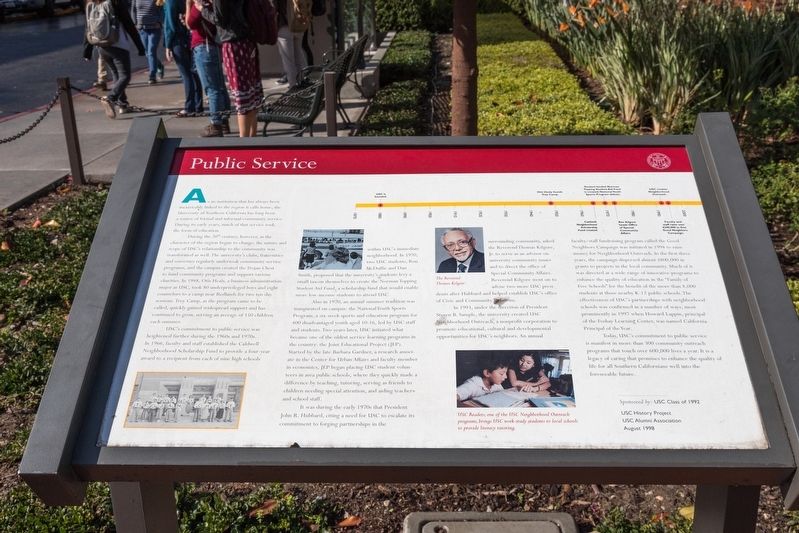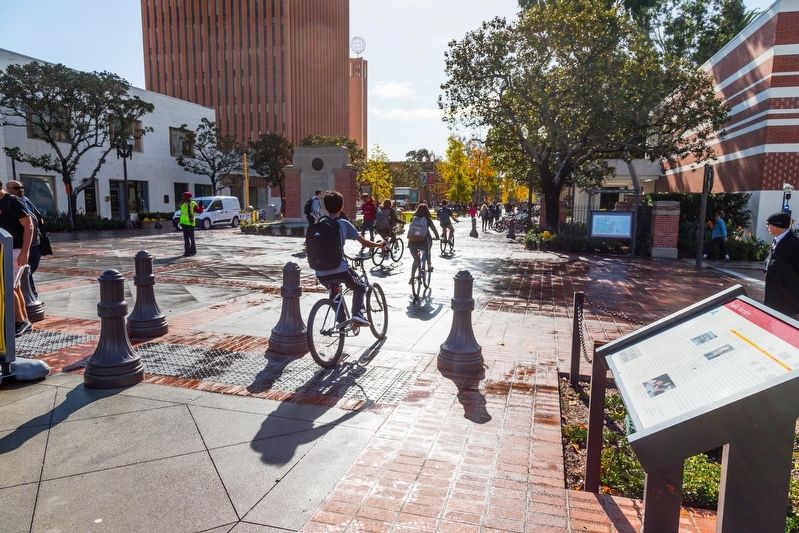South Los Angeles in Los Angeles County, California — The American West (Pacific Coastal)
Public Service
ó USC ó University of Southern California ó
During the 20th century, however, as the character of the region began to change, the nature and scope of USCís relationship to the community was transformed as well. The universityís clubs, fraternities and sororities regularly undertook community service programs, and the campus created the Trojan Chest to fund community programs and support various charities. In 1948, Otis Healy, a business administration major at USC, took 80 underprivileged boys and eight counselors to a camp near Redlands for two ten-day sessions. Troy Camp, as the program came to be called, quickly gained widespread support and has continued to grow, serving an average of 150 children each summer.
USCís commitment to public service was heightened further during the 1960s and 1970s. In 1966, faculty and staff established the Caldwell Neighborhood Scholarship Fund to provide a four-year award to a recipient from each of nine high schools within USCís immediate neighborhood. In 1970, two USC students, Ron McDuffie and Dan Smith, proposed that the universityís students levy a small tax on themselves to create the Norman Topping Student Aid Fund, a scholarship fund that would enable more low-income students to attend USC.
Also in 1970, an annual summer tradition was inaugurated on campus: the National Youth Sports Program, a six-week sports and education program for 400 disadvantaged youth aged 10-16, led by USC staff and students. Two years later, USC initiated what became one of the oldest service learning programs in the country: the Joint Educational Project (JEP). Started by the late Barbara Gardner, a research associ¨ate in the Center for Urban Affairs and faculty member in economics, JEP began placing USC student volun¨teers in area public schools, where they quickly made a difference by teaching, tutoring, serving as friends to children needing special attention, and aiding teachers and school staff.
It was during the early 1970s that President John R. Hubbard, citing a need for USC to escalate its commitment to forging partnerships in the surrounding community, asked the Reverend Thomas Kilgore, Jr. to serve as an advisor on university community issues and to direct the office of Special Community Affairs. Reverend Kilgore went on to advise two more USC presidents after Hubbard and helped establish USCís office of Civic and Community Relations.
In 1993, under the direction of President Steven B. Sample, the university created USC Neighborhood Outreach, a nonprofit corporation to promote educational, cultural and developmental opportunities for USCís neighbors. An annual faculty/staff fundraising program called the Good Neighbors Campaign was initiated in 1994 to raise money for Neighborhood Outreach. In the first three years, the campaign dispersed almost $800,000 in grants to projects in the local community. Much of it was directed at a wide range of innovative programs to enhance the quality of education in the “Family of Five Schools” for the benefit of the more than 8,000 students at those nearby K-12 public schools. The effectiveness of USCís partnerships with neighborhood schools was confirmed in a number of ways, most prominently in 1997 when Howard Lappin, principal of the Foshay Learning Center, was named California Principal of the Year.
Today, USCís commitment to public service is manifest in more than 300 community outreach programs that touch over 600,000 lives a year. It is a legacy of caring that promises to enhance the quality of life for all Southern Californians well into the foreseeable future.
Erected 1998 by USC History Project, USC Alumni Association. Sponsored by USC Class of 1992.
Topics. This historical marker is listed in these topic lists: Charity & Public Work • Education. A significant historical year for this entry is 1948.
Location. 34° 1.365′ N, 118° 17.033′ W. Marker is in Los Angeles, California, in Los Angeles County. It is in South Los Angeles. Marker is at the intersection of Trousdale Parkway and West 34th Street, on the left when traveling north on Trousdale Parkway. Touch for map. Marker is in this post office area: Los Angeles CA 90089, United States of America. Touch for directions.
Other nearby markers. At least 8 other markers are within walking distance of this marker. Foundersí Fountain (within shouting distance of this marker); The Ahn Family Residence (within shouting distance of this marker); The Trojan Column (within shouting distance of this marker); University of Southern California (within shouting distance of this marker); A Changing Campus (about 300 feet away, measured in a direct line); University Religious Center (about 400 feet away); An International University (about 400 feet away); Shrine Auditorium & Expo Center (about 400 feet away). Touch for a list and map of all markers in Los Angeles.
More about this marker. This panel shows a timeline from 1870 to 2000 marking when USC was founded, Otis Healy founded Troy Camp, the Caldwell Neighborhood Scholarship Fund was created, the Student-funded Norman Topping Student Aid Fund was created, the National Youth Sports Program debuted, Rev. Kilgore headed the Office of Special Community Affairs, USC creates Neighborhood Outreach, and when faculty and staff raised over $300 thousand in first Good Neighbors Campaign.
The interpretive panel has a number of illustrations (clockwise from top) beginning with a photographs of parents waving to campers leaving for Troy Camp; a portrait of ”the Reverend Thomas Kilgore;” “USC Readers, one of the USC Neighborhood Outreach programs, brings USC work-study students to local schools to provide literacy tutoring;” and a group of students holding letter-cards spelling “Give to the Trojan Chest.”
Also see . . . Good Neighbors Campaign. “Since 1994, USC faculty, staff and friends have donated more than $23 million dollars to support local community programs. Congratulations to the Good Neighbors Campaign (GNC) grant awardees for the 2017-2018 academic year. Funded programsí diverse scope of projects enables USCís partnerships to impact various educational and scientific pathways. A couple of this yearís funded organizations include Jumpstart and the Robotics and Coding Academy.” (Submitted on February 22, 2019.)
Credits. This page was last revised on January 30, 2023. It was originally submitted on February 22, 2019, by J. J. Prats of Powell, Ohio. This page has been viewed 214 times since then and 11 times this year. Photos: 1, 2. submitted on February 22, 2019, by J. J. Prats of Powell, Ohio.

